Adenomatoid tumor
| Adenomatoid tumor | |
| ICD-O: | 9054/0 |
|---|---|
| MeSH | D018254 |
Editor-In-Chief: C. Michael Gibson, M.S., M.D. [1] Associate Editor(s)-in-Chief: Sara Mohsin, M.D.[2]
Overview
Adenomatoid tumor is a benign mesothelial tumor affecting testicular adnexa. It generally presents in the genital tract, in regions such as the testis and epididymis.However, it also has been found in the pancreas.
Pathophysiology
- Adenomatoid tumors are benign, solid extratesticular lesions that can originate from the epididymis, tunica vaginalis, or spermatic cord.[1][2][3]
- They are the most common tumor of the epididymis.[4][5]
- They occur more often in the lower pole than in the upper pole by a ratio of 4:1.[6][7][8]
- Usually an incidental finding, adenomatoid tumors manifest as a painless scrotal mass, with the majority diagnosed in patients aged 20–50 years.[9][10][11]
- They are typically unilateral and occur more frequently on the left side. When they grow noninvasively into the testicular parenchyma, they can simulate intratesticular disease.[12][13][14][15]
Gross pathology
- 1 - 5 cm, well circumscribed solid tumor, adherent to testis / testicular adnexa
- Cut surface may have small cystic spaces
Histopathology
- No distinct growth pattern
- Unencapsulated, cuboidal to flat cells forming cords that are either epithelial-like or form channels with dilated lumina simulating vessels
- Cells have acidophilic cytoplasm with cytoplasmic vacuoles
- Nuclei lack nucleoli
- Mitoses and necrosis are usually absent
- Intervening stroma may have smooth muscle and elastic fibers, desmoplastic quality and inflammatory cells
- Rarely, tumor may extend into testicular parenchyma or even rarer, be totally inside the testis[5][13]
- Patterns have been described but most tumors show a mixture of:[16][17][18][19][20]
- Adenomatoid (tubular): glandular pattern with cytoplasmic vacuoles giving a signet ring appearance
- Angiomatoid (canalicular): cells have a more endothelial appearance
- Solid (plexiform): cells have a more epithelial appearance
- Cystic (mixed): rare; tumor is in form of cystic spaces lined by cuboidal to flattened lining epithelium
Cytology
- Smears are moderately cellular with sheets of monotonous round to oval cells showing indistinct cell borders and moderate to abundant pale cytoplasm with vacuolations [8][21]
- Nuclei are eccentric in location but regular with inconspicuous nucleoli[22][3]
Immunostaining
- Adenomatoid tumor stains positive for:[10]
- Calretinin
- Pan cytokeratins (EMA, AE1 / AE3, Cam5.2)
- CK5 / 6
- CK7 (variable, focal to diffuse)
- Adenomatoid tumor stains negative for:
- Vascular / endothelial markers (CD31, CD34)
- CEA
- HBME1
- Factor VIII Ag
- MOC31 / BerEP4
- B72.3
- CD15
- Ulex europeus agglutinin I
- Germ cell markers including:
- OCT3 / 4
- SOX2
- AFP
- PLAP
- CD117
- CD30
- NANOG
Electron microscopy
- Prominent microvilli
- Desmosomes
- Tonofilaments associated with dilated intercellular spaces
Causes
- Mesothelial origin based on immunohistochemical features and ultrastructural studies [23]
- Similar tumor in spermatic cord, ejaculatory duct, fallopian tube, uterus
Epidemiology and Demographics
- 30% of testicular adnexal tumors, 73% of benign tumors of testicular adnexa in study of 314 tumors[24]
- Usually 3rd to 5th decade; rare - 5 year old boy[25] and 70 year old man[26]
Natural History, Complications and Prognosis
- Uniformly benign behavior, no reports of malignant transformation
Diagnosis
- Diagnosis is suspected clinicoradiologically, confirmed histologically
History and Symptoms
Common sites of involvement
- Adenomatoid tumor most commonly involves the following sites:
Symptoms
- Presents as solid, well circumscribed mass in scrotum, often associated with pain
- Usually 1 - 5 cm, rarely larger[30]
- Benign, even if it extends into testis
Laboratory findings
- No specific laboratory finding; however, negative markers for germ cell tumor are helpful in excluding a germ cell malignancy
Ultrasound findings
- On an ultrasound, they appear as a solid extratesticular mass with variable echogenicity.[31]
- USG reveals a relatively hypo, iso to hyperechoic mass at lower pole of epididymis, not distorting the testis
MRI
- Commonly, MRI demonstrates low signal intensity relative to the testicular parenchyma on T2-weighted images.
- MRI can aid in determining the paratesticular origin of the lesion.
- Adenomatoid tumors enhance after administration of gadolinium contrast material.
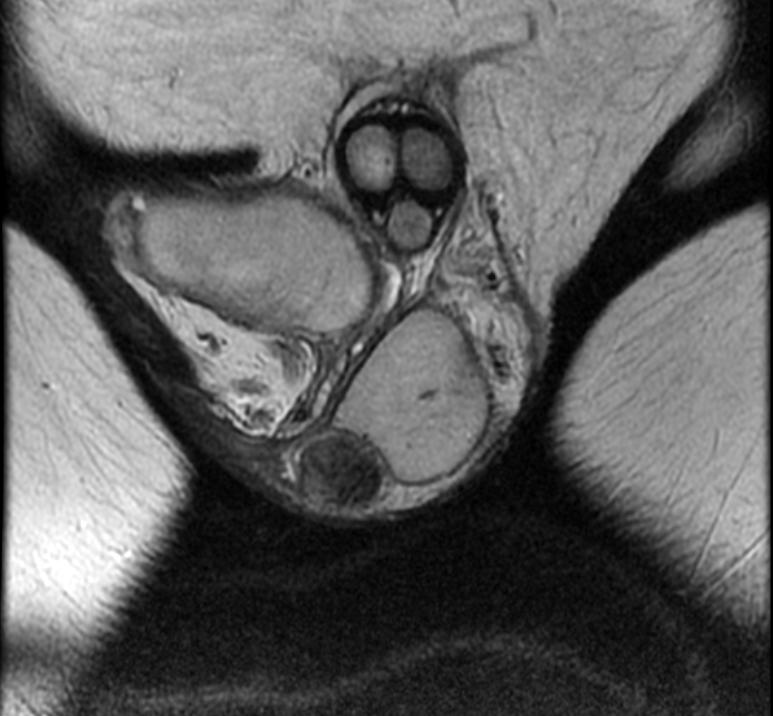 |
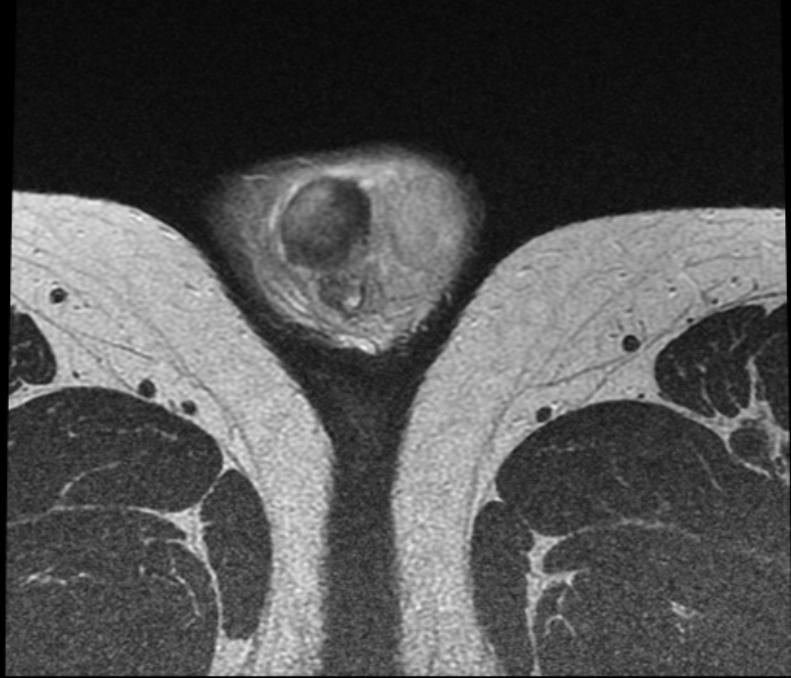 |
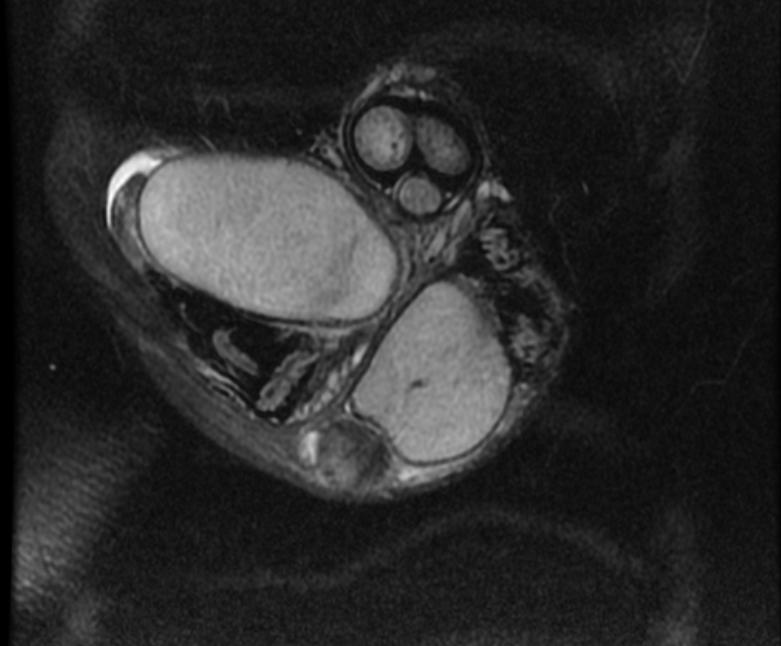 |
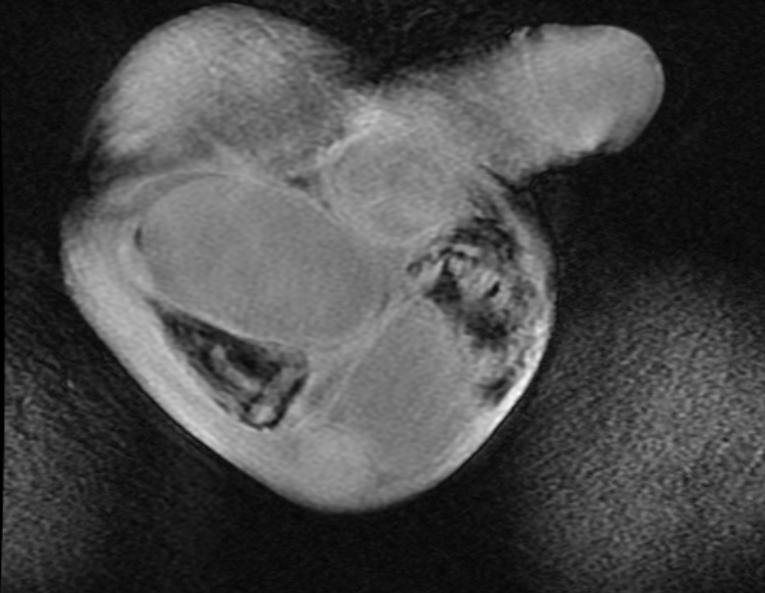 |
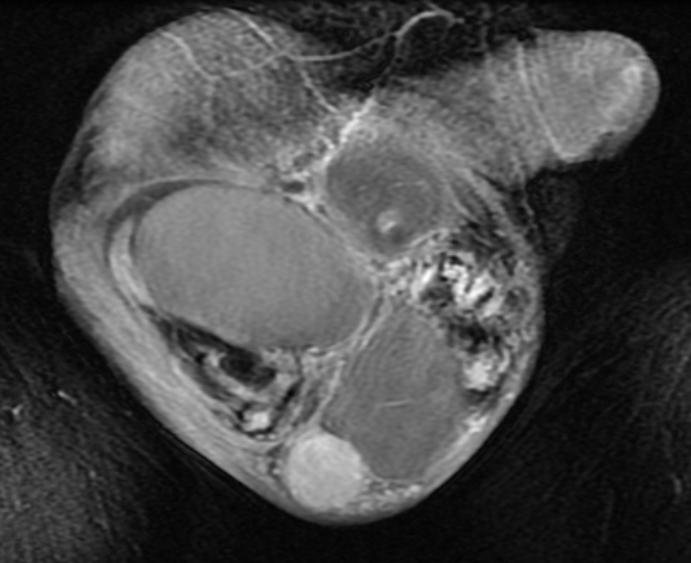 |
Treatment
Differentiating Adenomatoid tumor from other diseases
- Adenomatoid tumor must be differentiated from:
- Malignant mesothelioma (HBME1+, mitoses and necrosis)
- Metastatic adenocarcinoma (positive for one or more of CEA, PSA, MOC31 / BerEP4 and CD15 are useful)
- Papillary cystadenoma of epididymis
References
- ↑ Amin W, Parwani AV (2009). "Adenomatoid tumor of testis". Clin Med Pathol. 2: 17–22. PMC 2990235. PMID 21151545.
- ↑ Williams SB, Han M, Jones R, Andrawis R (2004). "Adenomatoid tumor of the testes". Urology. 63 (4): 779–81. doi:10.1016/j.urology.2003.11.035. PMID 15072910.
- ↑ 3.0 3.1 Alam K, Maheshwari V, Varshney M, Aziz M, Shahid M, Basha M; et al. (2011). "Adenomatoid tumour of testis". BMJ Case Rep. 2011. doi:10.1136/bcr.01.2011.3790. PMC 3063256. PMID 22707658.
- ↑ "Adenomatoid tumor of the epididymis". Retrieved 2007-12-15.
- ↑ 5.0 5.1 Migliorini F, Baldassarre R, Artibani W, Martignoni G, Brunelli M (2014). "Rare case of intra-testicular adenomatoid tumour". Arch Ital Urol Androl. 86 (1): 44–5. doi:10.4081/aiua.2014.1.44. PMID 24704932.
- ↑ 6.0 6.1 Oyama H, Ogawa M, Mikuriya H, Kido A, Hayashi H (2001). "[Adenomatoid tumor of testicular tunica albuginea: a case report]". Hinyokika Kiyo. 47 (9): 661–3. PMID 11692607.
- ↑ Shima M, Takahashi S, Maeda T, Masumori N, Itoh N, Tsukamoto T (2009). "[Adenomatoid tumor of the testis with testicular pain: a case report]". Hinyokika Kiyo. 55 (5): 285–6. PMID 19507549.
- ↑ 8.0 8.1 Kalyani R, Das S (2009). "Adenomatatoid tumor: Cytological diagnosis of two cases". J Cytol. 26 (1): 30–2. doi:10.4103/0970-9371.54865. PMC 3167987. PMID 21938146.
- ↑ Barry P, Chan KG, Hsu J, Quek ML (2005). "Adenomatoid tumor of the tunica albuginea". Int J Urol. 12 (5): 516–8. doi:10.1111/j.1442-2042.2005.01091.x. PMID 15948758.
- ↑ 10.0 10.1 Chen D, Yu Z, Ni L, Gui Y, Yang S, Shi B; et al. (2014). "Adenomatoid tumors of the testis: A report of two cases and review of the literature". Oncol Lett. 7 (5): 1718–1720. doi:10.3892/ol.2014.1938. PMC 3997688. PMID 24765207.
- ↑ 11.0 11.1 Alexiev BA, Xu LF, Heath JE, Twaddell WS, Phelan MW (2011). "Adenomatoid tumor of the testis with intratesticular growth: a case report and review of the literature". Int J Surg Pathol. 19 (6): 838–42. doi:10.1177/1066896911398656. PMID 21427102.
- ↑ "Modern Pathology - Adenomatoid Tumor of the Pancreas: A Case Report with Comparison of Histology and Aspiration Cytology". Retrieved 2007-12-15.
- ↑ 13.0 13.1 13.2 Samad AA, Pereiro B, Badiola A, Gallego C, Zungri E (1996). "Adenomatoid tumor of intratesticular localization". Eur Urol. 30 (1): 127–8. PMID 8854081.
- ↑ Pichler R, Tulchiner G, Steinkohl F, Soleiman A, Horninger W, Heidegger IM; et al. (2018). "Adenomatoid tumor of the testis mimicking malignant testicular cancer on multiparametric ultrasound". Eur J Med Res. 23 (1): 3. doi:10.1186/s40001-018-0301-5. PMC 5765709. PMID 29325584.
- ↑ Makkar M, Dayal P, Gupta C, Mahajan N (2013). "Adenomatoid tumor of testis: A rare cytological diagnosis". J Cytol. 30 (1): 65–7. doi:10.4103/0970-9371.107519. PMC 3643368. PMID 23661947.
- ↑ Taxy JB, Battifora H, Oyasu R (1974). "Adenomatoid tumors: a light microscopic, histochemical, and ultrastructural study". Cancer. 34 (2): 306–16. doi:10.1002/1097-0142(197408)34:2<306::aid-cncr2820340214>3.0.co;2-g. PMID 4277347.
- ↑ Quigley JC, Hart WR (1981). "Adenomatoid tumors of the uterus". Am J Clin Pathol. 76 (5): 627–35. doi:10.1093/ajcp/76.5.627. PMID 7293978.
- ↑ Yo H, Mori O, Ohaki Y, Kawamura T, Asano G (1996). "[Three cases of adenomatoid tumor of the uterus]". Nihon Ika Daigaku Zasshi. 63 (4): 294–8. PMID 8810558.
- ↑ Cheng CL, Wee A (2003). "Diffuse uterine adenomatoid tumor in an immunosuppressed renal transplant recipient". Int J Gynecol Pathol. 22 (2): 198–201. PMID 12649678.
- ↑ Otis CN (1996). "Uterine adenomatoid tumors: immunohistochemical characteristics with emphasis on Ber-EP4 immunoreactivity and distinction from adenocarcinoma". Int J Gynecol Pathol. 15 (2): 146–51. PMID 8786204.
- ↑ Gupta S, Garg S, Agarwal R, Sen R (2012). "Aspiration cytology of adenomatoid tumor of epididymis: An important diagnostic tool". J Surg Case Rep. 2012 (4): 11. doi:10.1093/jscr/2012.4.11. PMC 3649525. PMID 24960828.
- ↑ 22.0 22.1 Monappa V, Rao AC, Krishnanand G, Mathew M, Garg S (2009). "Adenomatoid tumor of tunica albuginea mimicking seminoma on fine needle aspiration cytology: a case report". Acta Cytol. 53 (3): 349–52. doi:10.1159/000325324. PMID 19534283.
- ↑ Marcus JB, Lynn JA (1970). "Ultrastructural comparison of an adenomatoid tumor, lymphangioma, hemangioma, and mesothelioma". Cancer. 25 (1): 171–5. doi:10.1002/1097-0142(197001)25:1<171::aid-cncr2820250125>3.0.co;2-2. PMID 5410308.
- ↑ Beccia DJ, Krane RJ, Olsson CA (1976). "Clinical management of non-testicular intrascrotal tumors". J Urol. 116 (4): 476–9. doi:10.1016/s0022-5347(17)58867-9. PMID 802862.
- ↑ Liu W, Wu RD, Yu QH (2011). "Adenomatoid tumor of the testis in a child". J Pediatr Surg. 46 (10): E15–7. doi:10.1016/j.jpedsurg.2011.06.020. PMID 22008356.
- ↑ Morote J, Rabella A, Benasco C (1984). "[Adenomatoid tumor of the epididymis]". Arch Esp Urol. 37 (1): 61–4. PMID 6721596.
- ↑ Cabral Ribeiro J, Sousa L, Gonçalves V (2018). "[Tunica albuginea adenomatoid tumor. A challenging case managed conservatively]". Rev Int Androl. 16 (2): 82–86. doi:10.1016/j.androl.2017.02.008. PMID 30300129.
- ↑ Sun AY, Polackwich AS, Sabanegh ES (2016). "Adenomatoid Tumor of the Testis Arising From the Tunica Albuginea". Rev Urol. 18 (1): 51–3. PMC 4859931. PMID 27162515.
- ↑ Pacheco AJ, Torres JL, de la Guardia FV, Arrabal Polo MA, Gómez AZ (2009). "Intraparenchymatous adenomatoid tumor dependent on the rete testis: A case report and review of literature". Indian J Urol. 25 (1): 126–8. doi:10.4103/0970-1591.45551. PMC 2684313. PMID 19468443.
- ↑ Ferenczy A, Fenoglio J, Richart RM (1972). "Observations on benign mesothelioma of the genital tract (adenomatoid tumor). A comparative ultrastructural study". Cancer. 30 (1): 244–60. doi:10.1002/1097-0142(197207)30:1<244::aid-cncr2820300135>3.0.co;2-c. PMID 5040745.
- ↑ Urkmez A, Akan S, Ozsoy E, Sahin A, Koca O, Ozturk MI (2018). "Diagnosis and Treatment of Paratesticular Adenomatoid Tumors". J Coll Physicians Surg Pak. 28 (9): S217–S219. doi:10.29271/jcpsp.2018.09.S217. PMID 30173704.
- ↑ Goel A, Jain A, Dalela D (2011). "Can radical orchiectomy be avoided for paratesticular adenomatoid tumor?". Indian J Urol. 27 (4): 556–7. doi:10.4103/0970-1591.91454. PMC 3263233. PMID 22279331.
- ↑ Subik MK, Gordetsky J, Yao JL, di Sant'Agnese PA, Miyamoto H (2012). "Frozen section assessment in testicular and paratesticular lesions suspicious for malignancy: its role in preventing unnecessary orchiectomy". Hum Pathol. 43 (9): 1514–9. doi:10.1016/j.humpath.2011.11.013. PMID 22406369.